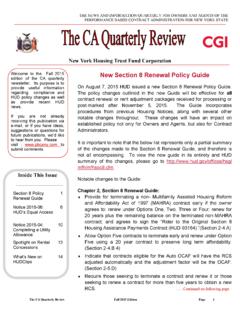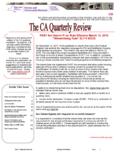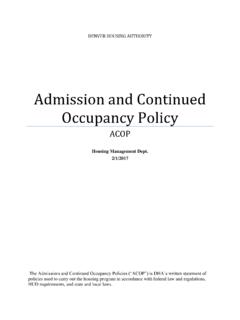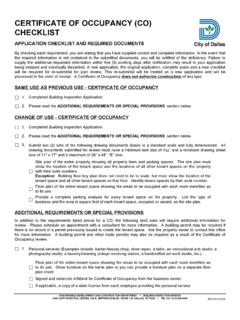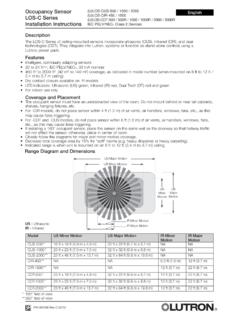Transcription of New York Housing Trust Fund Corporation HUD Posts New ...
1 THE NEWS AND INFORMATION QUARTERLY FOR OWNERS AND AGENTS OF THE. PERFORMANCE BASED CONTRACT ADMINISTRATION FOR NEW YORK STATE. New York Housing Trust Fund Corporation HUD Posts New guidance for management and occupancy Reviews Welcome to the Summer 2009 edition of the CA On June 3 HUD posted new guidance for HUD staff and PBCA s governing how management quarterly newsletter. Its and occupancy Reviews are conducted. This update, published in HUD Handbook , purpose is to provide useful REV1, CHG-2, Chapter 6 addresses areas related to the changes implemented with HUD Form information r e g a r d i ng 9834.
2 The discussion that follows includes only those provisions applicable to properties re- compliance and HUD policy viewed by Performance-based Contract Administrators and only those changes that impact changes as well as provide Owners and Agents. Projects reviewed by HUD or Traditional CA s may have other changes recent HUD news. that impact their reviews. Please review Chapter 6 in its entirety for more information on these types of properties. The following changes, with a proposed effective date of August 1, 2009. If you are not already will impact Owners and Agents when a Performance-based Contract Administrator performs receiving this publication via the on-site management and occupancy Review.
3 E-mail or if you have ideas, suggestions or questions for An important change is how category and overall ratings on the report are determined. Going future publications, we'd like forward, specific, numerical calculations will be used to determine ratings. HUD calls these to hear from you. Please performance indicators . guidance on how to determine these ratings is explained in detail in go to : Chapter 6, which now includes a discussion on the Above Average rating. Prior to the release of this chapter, HUD had no guidance related to this rating.
4 Going forward, the following will be applied to determine this rating category: Above Average Rating. Performance should be rated above average if: Owner/agent has established policies and procedures which are successful in carrying out the objectives of HUD Housing programs ( , provisions of well- maintained Housing at the lowest possible rents and proper use and concern for Federal subsidy and insurance funds);. Inside this issue: Owner/agent strictly adheres to procedures, with very few exceptions, resulting in compliance with the regulatory agreement, subsidy and mortgage contracts, New guidance for management 1 and management certifications; and and occupancy reviews Incidences of errors disclosed in the review are minimal and there are no major adverse findings are made.
5 New HAP Contract Exhibit 4. In addition, the Unsatisfactory rating category has undergone several important updates. Clarification of RCS requirements 5. Some of the new updates include the following: Translated HUD model Leases 5. Unsatisfactory Ratings. Performance should be rated Unsatisfactory if: There are repeat major adverse findings;. Vouchering Tips 6 There are open findings from prior year s management reviews;. Disaster Recovery guidance 8 It is important to note that the list above only reflects some of the new indicators.
6 For a com- plete list of indicators for Unsatisfactory Ratings, please refer to Chapter 6, Section 6-11 B. UIV Deadline Looms 8. Examples of major adverse findings include, but are not limited to, willful failure to maintain Tenant Selection Plans 9 the property in an acceptable physical condition; unauthorized distributions; willful failure to remit payments to the note holder; implementation of unauthorized rent increases; failure to recertify tenants; fraudulent recertifications by the owner/agent; and failure to comply with fair Housing laws.
7 As a part of this evaluation the reviewing official should consider whether the owner/agent has the capabilities and/or desire to implement the necessary changes to cure the deficiencies.. continued on page 2. The CA Quarterly Review Summer 2009 Edition Page 1. New guidance for management and occupancy Reviews ( continued from page 2). New to the chapter is a formal system of weighted values to determine categorical ratings for each category listed on HUD Form 9834. The maximum numerical weight value is based on the level of risk for the deficiencies in that category.
8 Please note: Section D, Financial management /Procurement is not reviewed or rated by Performance-based Contract Administrators. They are as follows: Category Rated Questions Maximum Numerical Weight A. General Appearance and Security 1 and 2(c) and 2(d) 10. B. Follow-up and Monitoring of Project 3(a) and 3(b) and 4(a) and 4(b) 20. Inspections C. Maintenance and Standard Operat- 5(b), 5(c), 5(e), 5(g), 5(h), 5(i), 5(j), 5(k), and 5(m) 10. ing Procedures 6(b) and 6(d) and 7(a) and 7(b). D. Financial management /Procurement 8(a), 8(b), 8(c), and 8(d) 9(a), 9(b), 9(c), 9(d), 9(e), 9 20.
9 NOTE: Not rated by PBCA's (f), and 9(g). 10(a) and 10(b) and 11(b), 11(c), 11(d), 11(g), 11(h), and 11(i). 12(a), 12(b), 12(c), and 12(d). 13(a), 13(b), 13(c), 13(d), 13(e), 13(f), 13(g), 13(h), 13(i), and 13(j). E. Leasing and occupancy 14(a), 14(c), 14(d), 14(e), 14(g), 14(h), 14(i), 14(j), 14 20. (k), and 14(l). 15(a), 15(c), 15(d), 15(e), and 15(f). 16(a), 16(b), 16(c), and 16(d). 17(a) and 17(b). 18(a), 18(b), 18(d), and 18(e). All questions for item 19. F. Tenant/ management Relations 20(a), 20(b), and 20(d) 10. 21(c), 21 (d), 21(i), and 21(j).
10 G. General management Practices 22(a), 22(b), 22(e), 22(f), 22(g), and 22(h) 10. 23(a), 23(b), and 23(c). 24(a) and 24(c). Once each category is rated, reviewers must apply a formula to determine the weight for each category. This weighted score will be used to determine the overall score. Chapter 6, Section 11-C instructs the following weights to be used: For categories with a maximum numerical weight of 20. Subtract 0 for Superior Subtract 4 for Above Average Subtract 6 for Satisfactory Subtract 8 for Below Average Subtract 20 for Unsatisfactory For categories with a maximum numerical weight of 10.
